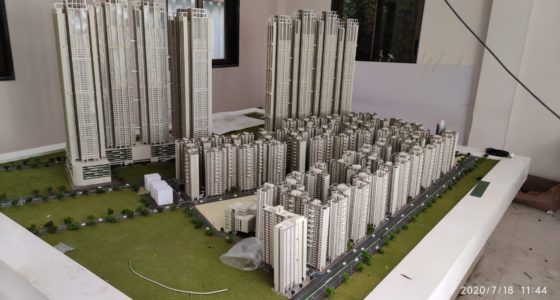The Indian residential real estate market experienced a notable slowdown in the first quarter of 2025, with housing sales across the top seven cities declining by 28% year-on-year (Y-o-Y). According to the latest data from ANAROCK Research, approximately 93,280 units were sold in Q1 2025, a sharp drop from the record-breaking 1.30 lakh units sold in the same period in 2024.
Skyrocketing property prices and geopolitical uncertainties have been cited as primary reasons for the decline in sales. “MMR and Pune accounted for 51% of the total sales, with MMR seeing a 26% yearly drop and Pune witnessing a decline of over 30%. Hyderabad recorded the highest annual drop in sales at 49%, while Bengaluru had the lowest decline at 16%,” said Anuj Puri, Chairman of ANAROCK Group.
New Launches Drop by 10% Y-o-Y
New housing supply also took a hit in Q1 2025, witnessing a 10% annual decline. The total number of new launches across the top seven cities fell from approximately 1.11 lakh units in Q1 2024 to just over 1 lakh units in Q1 2025.
Despite this decline, new launches in NCR, Bengaluru, and Kolkata surged by 53%, 27%, and 26%, respectively. However, other cities recorded substantial drops, with Hyderabad witnessing the highest decline of 55% Y-o-Y.
Luxury and ultra-luxury homes (priced above INR 1.5 crore) dominated the new supply, comprising 42% of the total launches. The premium segment (INR 80 lakh – INR 1.5 crore) followed with a 27% share, while mid-segment homes (INR 40-80 lakh) and affordable housing (under INR 40 lakh) accounted for 18% and 12%, respectively.
City-Wise Breakdown of New Launches
Among the top markets, Mumbai Metropolitan Region (MMR) and Bengaluru saw the highest number of new launches, accounting for 52% of the total supply in Q1 2025. While MMR witnessed a 9% dip in new launches, Bengaluru recorded a 27% Y-o-Y rise. Pune’s new supply declined by 10%, while NCR saw a significant increase of 53%.
| City | Q1 2025 New Launches | Q1 2024 New Launches | % Change |
|---|---|---|---|
| NCR | 11,120 | 7,270 | +53% |
| MMR | 30,755 | 33,800 | -9% |
| Bengaluru | 20,855 | 16,485 | +27% |
| Pune | 16,860 | 18,770 | -10% |
| Hyderabad | 10,275 | 22,960 | -55% |
| Chennai | 4,755 | 7,290 | -35% |
| Kolkata | 5,400 | 4,290 | +26% |
| Total | 1,00,020 | 1,10,865 | -10% |
Sales Performance Across Major Cities
In terms of sales, MMR led the market with 31,610 units sold in Q1 2025, marking a 26% decline from Q1 2024. Pune followed with 16,100 units sold, recording a 30% dip. Bengaluru saw the lowest drop at 16%, with 15,000 units sold.
Hyderabad recorded the steepest fall in sales at 49%, with only 10,100 units sold compared to 19,660 in Q1 2024. NCR, Chennai, and Kolkata also witnessed significant drops ranging between 20% and 31%.
| City | Q1 2025 Sales | Q1 2024 Sales | % Change |
| NCR | 12,520 | 15,650 | -20% |
| MMR | 31,610 | 42,920 | -26% |
| Bengaluru | 15,000 | 17,790 | -16% |
| Pune | 16,100 | 22,990 | -30% |
| Hyderabad | 10,100 | 19,660 | -49% |
| Chennai | 4,050 | 5,510 | -26% |
| Kolkata | 3,900 | 5,650 | -31% |
| Total | 93,280 | 1,30,170 | -28% |
Price Trends and Unsold Inventory
Despite the decline in sales, property prices continued to rise. Average residential prices in the top seven cities surged by 17% annually, with NCR and Bengaluru recording the highest jumps of 34% and 20%, respectively.
At the same time, unsold inventory in these cities dropped by 4% Y-o-Y, falling from approximately 5.80 lakh units at the end of Q1 2024 to 5.60 lakh units by the end of Q1 2025. Pune saw the steepest decline in unsold inventory at 16%, whereas Bengaluru recorded a 28% increase in available stock.
Market Outlook
Industry experts believe that while India’s macroeconomic fundamentals remain strong, rising property prices and global uncertainties are creating short-term hurdles for the housing market. “India’s overall economic scenario remains positive, with GDP growth expected to be among the highest globally and inflation under control. However, rising housing prices and global headwinds have impacted the residential market in Q1 2025,” Puri added.
Going forward, developers may focus more on right-sizing and right-pricing strategies to boost affordability and attract demand, particularly in the mid and affordable housing segments. The market’s trajectory in the coming quarters will largely depend on interest rate movements, economic stability, and global geopolitical developments.
Also Read: Akshay Kumar real estate









